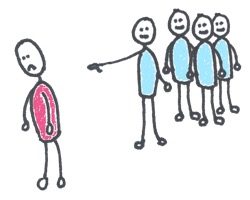The Equality Act 2010 protects employees and job applicants from being subjected to discrimination (less favourable treatment). It makes it unlawful to treat a person, or group of people, differently or subject them to harassment on the grounds of certain defined areas. The act refers to these areas or classification as protected characteristics.
Definition of Protected Characteristics
The term protected characteristics describes any one of the following classifications:
- Age;
- Disability;
- Gender Reassignment;
- Marriage and Civil Partnership
- Sex;
- Sexual Orientation;
- Race (including colour, nationality, ethnicity, ethnic or national origin);
- Religion or Belief.
Pregnancy, maternity leave and breast feeding: the missing protected characteristics
Interestingly, law makers did not choose to define maternity and pregnancy as a protected characteristic. Protection is afforded in the act separately and those in this category may find that there is an overlap between this and the protected characteristic of sex. By way of example, consider the situation in which a company decides it will not allow women to return to work after maternity leave. This would be unlawful under maternity discrimination law and detrimental to women in general (sex discrimination)
When is unfavourable treatment not discrimination?
 It is not unlawful to discriminate against a person on any other basis than those mentioned above. Surprisingly, a person could be treated less favourably at work on the basis that they were overweight, tall or had a cockney accent and the Equality Act would offer no protection. A person in such circumstances may feel that the treatment was sufficiently serious to force them to resign and claim constructive dismissal but they would need two year’s continuous employment to qualify for protection from this sort of bullying.
It is not unlawful to discriminate against a person on any other basis than those mentioned above. Surprisingly, a person could be treated less favourably at work on the basis that they were overweight, tall or had a cockney accent and the Equality Act would offer no protection. A person in such circumstances may feel that the treatment was sufficiently serious to force them to resign and claim constructive dismissal but they would need two year’s continuous employment to qualify for protection from this sort of bullying.
Tom Street qualified as a solicitor in 2003 and has over 20 years experience in employment and litigation law. He studied law at the University of Manchester before undertaking the legal practice course at the College of Law in Guildford, going on to complete his legal training at a firm in Chancery Lane, London. Once fully qualified, he moved to a niche litigation practice in the City of London.
In 2010, Tom set up his own legal practice, Tom Street & Co Solicitors and as part of this, in accordance with his strongly held objective to provide everyone with an easy pathway to justice he established the online portals Do I Have A Case? and Tribunal Claim. These websites are trading names of Tom Street & Co Solicitors.

